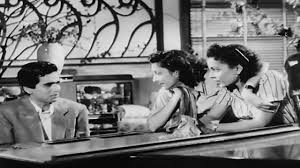Raju Korti
For the past two days, I am watching runs and re-runs of this audio-video clip of the rapturous Lata Mangeshkar-Shamshad Begum duet from the 1949 blockbuster 'Andaaz' like a man possessed. With an extravagant and bloated presentation puffed up by a heavy-duty star cast that had become synonymous with (then) film-makers like Mehboob Khan and K Asif, certain parts of the movie still stand out for their cinematic brilliance. Which happens to be the focal point of this essay!
The song in question "Dar na muhabbat kar le" is perhaps just another lilting song from the stable of the brilliant Naushad, sometimes frowned upon for being classical for the sake of classical. It is actually the on-screen chemistry of the three pivotal performers -- Dilip Kumar, Nargis and Cuckoo. Peppered by superb conceptualization and some veracious camera angles that pan onto each one of them just at the precise time; make for the cinematic discernment that hems in so resoundingly.
 |
| Dilip Kumar, Nargis and Cuckoo in Andaaz |
You have to watch the song clip and deploy your musical senses and visual aesthetics together to get the import of the cinematic brilliance that I speak of. Everything about it is one. The performers -- Dilip Kumar playing the Piano and the two lead ladies Nargis and Cuckoo leaning against it -- the song, the music, the melody, the situation, the expression, the feel seem like one entity in the 3.21 minute clip. There are no cues singled out here which speaks volumes of the levels of amalgamation each have inoculated into those spell-binding moments.
For all those wondering why I am making a song and dance about just this one song, there is a simple reason. It is just a reference point in my understanding of cinematic brilliance as an outcome of oneness extracted out of diversity. Mehboob Khan has proved equal to that challenge and how! Of course, there are many situations handled adeptly by different film-makers almost as well in the past. One that immediately comes to mind is the situation of that iconic song "Din dhal jaaye, haaye raat na jaaye" from Guide (1965). Vijay Anand was a master who could seamlessly fuse every character and parameter required for the shot. How smoothly he drives you into the skin of the song sequence where a Dev Anand in drunken stupor starts humming to Rafi's velvety vocals. That is/was a talent not everybody's cup of tea, Come to think of it, you shudder to think what Dev Anand would have himself done if he were to direct this film the way he went about in the post Hare Rama Hare Krishna period.
In my perspective, cinematic brilliance is all about viewers feeling long and lasting emotions about a person or situation or the scene itself. A lyrically meaningful song interspersed coherently adds up to artistic finnesse. The better the aesthetics of this complex grammar, the better the cinematic brilliance quotient. A scene is helped immeasurably by performers, the feelings they emote, the lyrics, the tune and all those who make that happen in a synchronized chorus. That includes those behind the scenes like technicians who put it on the larger canvass. It make the audience sit straight and take notice and be silent and introspective. The Lata-Shamshad duet sequence in Andaaz is a story all by itself. More evocative than the cliched claim of the film being India's ostensibly first 'love triangle" story.
It is quite another story that the Anglo-Indian Cuckoo who lived a lavish and carefree life and was the undisputed queen of cabaret/club songs much before Helen staked claim to her legacy, died unsung. Not one from the film industry turned up for the funeral of the nimble-foot dancer who cast a mesmerizing spell in her prime. The words in her own lip-synched Andaaz song tell the story:
Duniya Fani, Tu Bhi Fani, Leta Ja Ulfat Ki Nishani
Do Lafzo Ki Ek Kahani, Ek Mohabbat Ek Jawani
Yad Isse Tu Karle, Yad Isse Tu Karle
If only some of the cinematic brilliance and sensibility had spilled off-celluloid too.




Raju Garu - " Brilliant " - :) :) :)
ReplyDelete